Yield in agriculture refers to the average net output you get per unit of land each year, like bushels per acre or tons per hectare. It's a key measure of efficiency and productivity, showing how well you're using your land and resources. Different factors affect yield, including soil health, weather conditions, and pest management practices. You can measure yield using techniques like plot sampling, counting methods, or advanced tools like remote sensing. Understanding yield is crucial for making informed decisions in farming, and there's much more to uncover about its implications in modern agriculture.
Key Takeaways
- Yield in agriculture measures the average net output per unit of farmland annually, often expressed in bushels per acre or tons per hectare.
- Higher yields indicate more efficient land use and resource management, critical for assessing agricultural productivity and profitability.
- Factors affecting yield include soil health, weather conditions, pest management, crop varieties, and agricultural practices.
- Increased yield contributes to food security, economic benefits, and environmental advantages, supporting sustainable farming practices.
- Yield can be measured through various methods, including plot sampling, remote sensing, yield monitors, and yield component analysis.
Yield Measurement Fundamentals
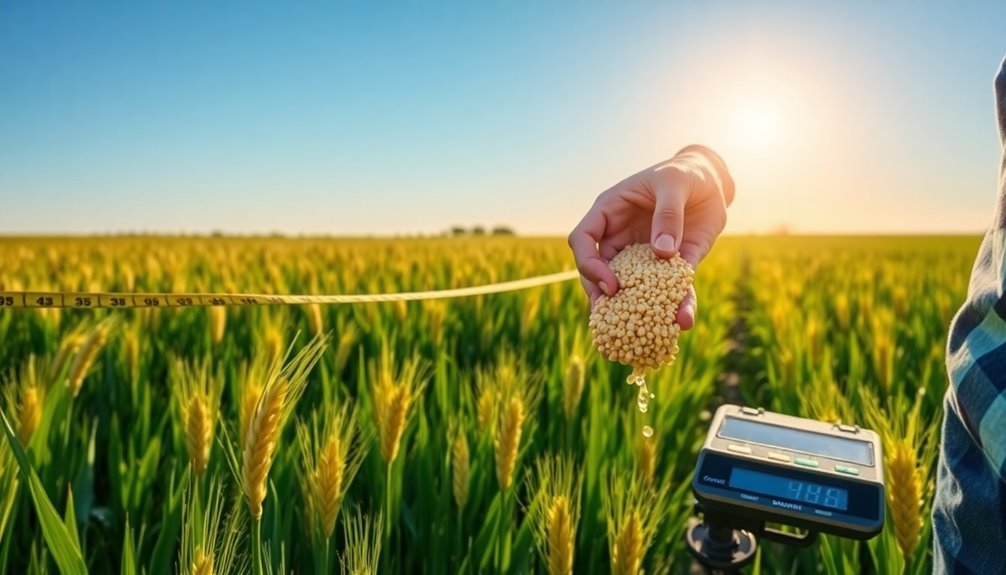
Yield measurement in agriculture is critical for assessing crop productivity and making informed decisions. You can utilize various yield estimation methods to get accurate results.
One common approach is plot sampling, where you take samples from specific areas and weigh them, ensuring you sample multiple plots for a representative average.
Another method involves counting heads or pods in a designated area, like one square meter, and averaging the counts. Additionally, measuring grain weight by counting grains in heads or pods helps refine your yield calculations. Tracking costs and quantities improves accuracy in yield management and can significantly enhance your overall farming efficiency.
For advanced options, consider remote sensing with drones or satellites for large fields, or yield monitors for real-time data during harvest. Each method has its benefits, so choose the one that fits your needs best.
Yield Definition in Agriculture

When defining agricultural yield, it's essential to understand that it measures the average net output of products per unit of farmland each year. Yield can be quantified in various terms, such as calories, grams of protein, or net profit.
It includes all land necessary for producing the output, including land for feeds or manure. Various interconnected factors, like climate, temperature, and soil nutrient management, influence yield. Conservation tillage practices can also slightly enhance agricultural yield by promoting soil health and biodiversity.
While yield serves as a partial measure of productivity, it doesn't account for all inputs and costs associated with farming. Ultimately, crop yield plays a crucial role in global food production, impacting national trade and agricultural business decisions, making it vital for both food security and economic stability.
Yield Calculation Methods

Calculating agricultural yield involves several methods, each suited to different contexts and needs.
One common approach is the Plot Sampling Method, where you take a crop sample from a specific area and weigh it, then extrapolate that data to estimate yield for the entire field.
If you need to cover large areas quickly, the Remote Sensing Method utilizes satellite imagery or drones, though it requires specialized training and equipment. This method can be particularly effective for assessing high yield crops across vast regions.
The Yield Monitors Method measures yields in real-time during harvest, providing immediate data but can be costly.
Lastly, the Yield Component Method focuses on factors like the number of ears per acre and kernel weight, allowing for early estimates before harvest.
Each method has its unique advantages and applications.
Pros and Cons of Yield
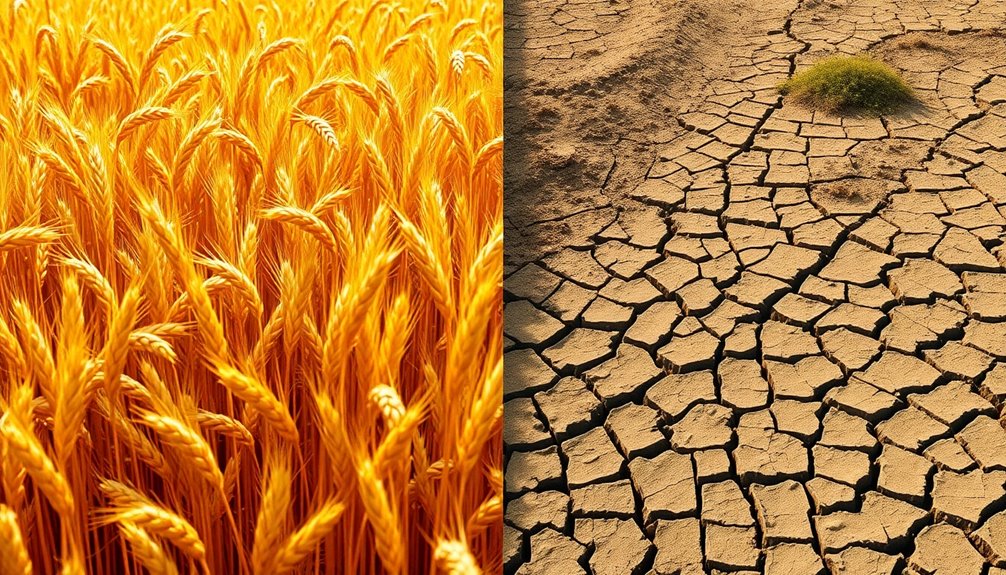
Agricultural yield plays a significant role in shaping food production and economic landscapes. High crop yields can increase food production, meeting the demands of a growing population and enhancing food security. Additionally, understanding factors affecting yield is crucial for improving agricultural productivity.
You'll also find economic benefits, as higher yields boost agricultural income and create jobs, stimulating local economies.
However, there are downsides. Increased reliance on pesticides and fertilizers can harm the environment and water quality. The push for high yields may favor large farms, potentially displacing small-scale farmers.
Furthermore, health risks from chemical inputs and the stress of intensive farming can affect both farmers and consumers.
Balancing the pros and cons of yield is essential for sustainable agriculture and economic stability.
Yield vs. Input Costs
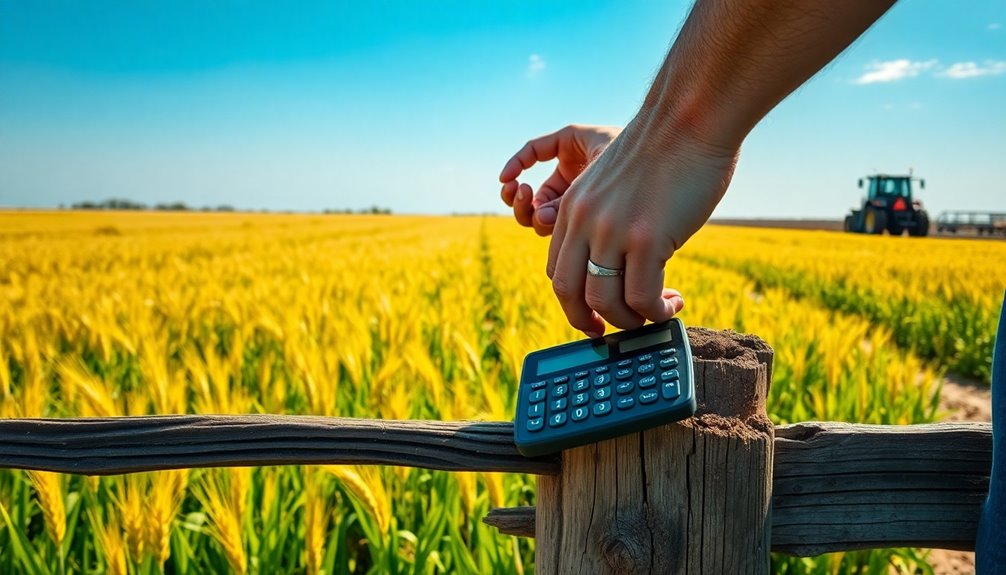
Understanding the relationship between yield and input costs is crucial for maximizing profitability in farming. Input costs have more than doubled in the past decade, often ranging from 26% to 35% of gross crop income. Notably, the total spend on inputs rose by 139% from 2013 to 2022, indicating a significant trend that farmers must navigate.
Balancing realistic yield goals against production costs helps you manage these expenses effectively. While cutting back on certain inputs might seem tempting, it's essential to make calculated decisions. Utilizing crop rotation can lower fertilizer and seed costs, while efficient soil and nutrient management is vital for high yields. Remember, controlling costs while optimizing yield potential is key.
With rising fixed costs, keeping a close eye on input usage can significantly impact your bottom line and help mitigate financial risks.
Pest Infestations and Diseases

While you might focus on maximizing yields, pest infestations and diseases can significantly threaten your crops. Each year, pests cause a staggering 20% to 40% loss in global crop production, with invasive insects costing the economy around $70 billion.
For staple crops like maize and rice, yield reductions can range from 30% to 80%, depending on the specific pest and region. Climate change further complicates matters, as rising temperatures can boost insect populations and shift their habitats. This not only affects your crop yield but can also lead to substantial financial losses, with plant diseases alone costing about $220 billion globally. Being proactive with pest management is essential to safeguard your yields and protect your investment. Moreover, climate change is projected to reduce yields for major crops due to pest and disease pressures.
Precision Agriculture Innovations
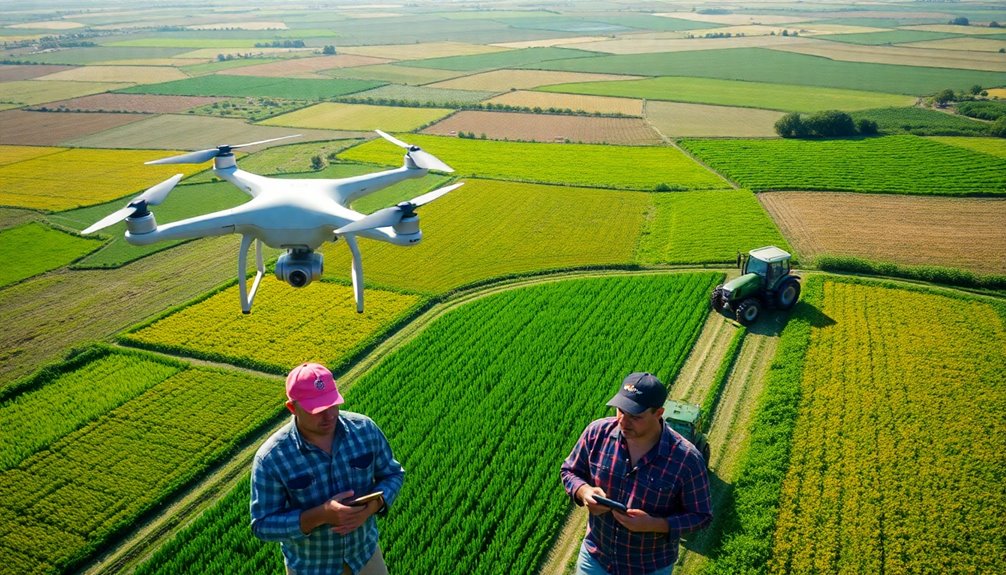
To combat the challenges posed by pest infestations and diseases, farmers are turning to precision agriculture innovations that enhance crop management.
GPS guidance systems allow you to navigate fields accurately, minimizing overlap and ensuring efficient planting, fertilizing, and harvesting.
Meanwhile, sensor and IoT technologies provide real-time data on soil moisture and crop health, giving you actionable insights for better resource allocation. Precision agriculture increases crop yields by up to 30%, further motivating farmers to adopt these technologies.
Satellite imagery combined with AI and machine learning helps predict yield and assess crop conditions, allowing for timely interventions.
Additionally, variable rate technology and GIS mapping enable precise application of fertilizers and water, reducing waste.
Crop Rotation Benefits
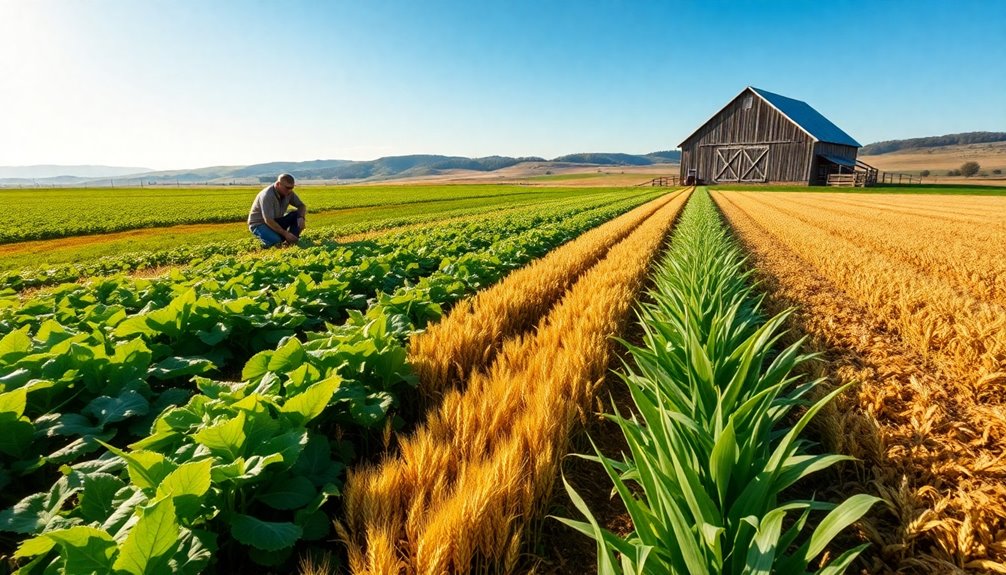
Crop rotation offers numerous benefits that can significantly enhance your agricultural practices. By alternating crops, you're replenishing nutrients in the soil, improving its structure, and reducing compaction. This increases water availability, minimizing stress on your plants and cutting down on fertilizer needs. Moreover, studies have shown that increased active crop time can lead to higher yields by enhancing soil coverage and reducing erosion.
You also disrupt the life cycles of pests and diseases, reducing their presence and decreasing your reliance on chemical pesticides. Moreover, crop rotation helps manage water resources efficiently and prevents soil erosion, maintaining soil health even in unpredictable weather. Economically, it boosts crop yields while diversifying your output, reducing the risk of total crop failure. Overall, you'll enjoy both financial benefits and a healthier environment.
Frequently Asked Questions
How Does Weather Affect Agricultural Yield?
Weather significantly affects agricultural yield in various ways. When rain's excessive, it can flood fields, erode soil, and delay planting, ultimately harming your crops.
Strong winds can uproot plants and carry away vital nutrients. Temperature extremes, whether freezing or scorching, can stunt growth or cause sunburn, impacting your harvest.
As climate change intensifies these weather patterns, you face increasing challenges in maintaining consistent yields and ensuring food security for your community.
What Crops Typically Have the Highest Yield?
When it comes to crops, think of high-yield varieties as the stars of the agricultural show.
You'll find wheat and corn leading the pack, with corn boasting yields of up to 14.1 MT·ha⁻¹.
Soybeans and canola also shine brightly, delivering impressive returns.
Don't overlook specialties like tomatoes and potatoes—they're cash crops that bring both yield and profit.
How Can Farmers Improve Their Yield?
To improve your yield, you can adopt precision agriculture techniques like GPS and remote sensing to optimize planting and crop management.
Implement soil moisture sensors and efficient irrigation practices to ensure your plants receive the right amount of water.
Consider crop rotation and cover cropping to enhance soil health and fertility.
Lastly, utilize data analytics and drones to monitor crop performance and make informed decisions based on real-time insights.
What Role Do Fertilizers Play in Yield?
You mightn't realize it, but fertilizers are like a magic potion for your crops. They supply essential nutrients that promote growth and resilience, allowing plants to thrive.
By enhancing nutrient availability, fertilizers lead to higher yields and better quality produce. Without them, you'd see a significant drop in crop output.
How Is Yield Data Collected and Analyzed?
To collect and analyze yield data, you'll use various methods like agricultural surveys, farm records, and remote sensing technologies.
You might employ yield monitors for real-time measurements during harvest. Advanced tools such as IoT sensors and satellite imagery can help gather vital information on crop health.
Once collected, you can analyze the data using statistical software, crop yield mapping, and machine learning algorithms to accurately predict and visualize yield trends.
Conclusion
In agriculture, understanding yield is crucial for maximizing your crop potential and profitability. By measuring yield accurately and considering factors like input costs, pests, and innovative practices, you can truly reap the rewards of your hard work. With precision agriculture and smart crop rotation, you've got the tools to enhance your yields and make every acre count. Remember, when it comes to farming, you've got to make hay while the sun shines!









